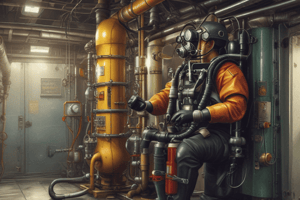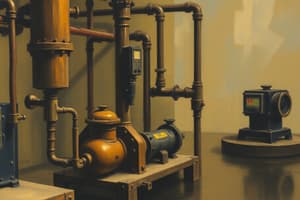Podcast
Questions and Answers
What are the primary uses of compressed air?
What are the primary uses of compressed air?
- Power, Control, and Storage
- Power, Process, and Distribution
- Power, Process, and Control (correct)
- Power, Regulation, and Transport
What is the main concern for factories using compressed air systems?
What is the main concern for factories using compressed air systems?
- System Reliability (correct)
- Compressed Air Quality
- Energy Efficiency
- Production Cost
What defines the Compression Ratio (CR) of air?
What defines the Compression Ratio (CR) of air?
- The weight of the air before and after compression
- The volume reduction ratio before and after compression (correct)
- The temperature change during compression
- The time taken for compression
What does the Free Air Delivered (FAD) measure?
What does the Free Air Delivered (FAD) measure?
What happens to the energy stored in compressed air when it expands?
What happens to the energy stored in compressed air when it expands?
What aspect of the compressed air system often gets overlooked despite its cost?
What aspect of the compressed air system often gets overlooked despite its cost?
Which of the following is NOT a component of a compressed air system?
Which of the following is NOT a component of a compressed air system?
How is FAD rating affected by changes in ambient conditions?
How is FAD rating affected by changes in ambient conditions?
What is the main issue caused by inadequate storage in a compressor system?
What is the main issue caused by inadequate storage in a compressor system?
What pressure fluctuation is relied upon by load/no load controls in screw compressors?
What pressure fluctuation is relied upon by load/no load controls in screw compressors?
What is a negative consequence of rapid pressure fluctuations in compressor systems with limited storage?
What is a negative consequence of rapid pressure fluctuations in compressor systems with limited storage?
How does modulation control differ from load/no load controls?
How does modulation control differ from load/no load controls?
What happens when the pressure in a compressor exceeds 6.9 bar with modulating control?
What happens when the pressure in a compressor exceeds 6.9 bar with modulating control?
What is the impact of a 10% reduction in pressure on mass within a fixed volume?
What is the impact of a 10% reduction in pressure on mass within a fixed volume?
At what load percentage do most modulating compressors transition to a more efficient load/unload mode?
At what load percentage do most modulating compressors transition to a more efficient load/unload mode?
What advantage does rotor length control provide in a compressor system?
What advantage does rotor length control provide in a compressor system?
What is the main disadvantage of start/stop control in high kW motors?
What is the main disadvantage of start/stop control in high kW motors?
How does load/unload control differ from start/stop control?
How does load/unload control differ from start/stop control?
What role does the pressure switch play in load/unload control?
What role does the pressure switch play in load/unload control?
What is a significant concern for using start/stop control in large industrial compressors?
What is a significant concern for using start/stop control in large industrial compressors?
Under what conditions is load/unload control considered effective?
Under what conditions is load/unload control considered effective?
Which method uses a pressure switch to manage the compressor's operation?
Which method uses a pressure switch to manage the compressor's operation?
What is the main benefit of managing effective rotor compression length in compressors?
What is the main benefit of managing effective rotor compression length in compressors?
What is the outcome of reaching the cut-out pressure in load/unload control?
What is the outcome of reaching the cut-out pressure in load/unload control?
Which method is mentioned for rotor length control in compressors?
Which method is mentioned for rotor length control in compressors?
How much water accumulates in the aftercooler based on the given conditions?
How much water accumulates in the aftercooler based on the given conditions?
What pressure range typically characterizes load/unload control for compressors?
What pressure range typically characterizes load/unload control for compressors?
What does the pressure dew point (PDP) represent in compressed air systems?
What does the pressure dew point (PDP) represent in compressed air systems?
Which of the following factors contributes to the accumulation of condensate in the air system?
Which of the following factors contributes to the accumulation of condensate in the air system?
What happens when the air cools down in the compressor system?
What happens when the air cools down in the compressor system?
Which of the following air treatment aspects is critical for compressed air systems?
Which of the following air treatment aspects is critical for compressed air systems?
How does effective rotor length control impact compressor efficiency?
How does effective rotor length control impact compressor efficiency?
What does a low PDP value indicate in compressed air?
What does a low PDP value indicate in compressed air?
Which condition is NOT considered the worst-case scenario for the application of refrigerated air dryers?
Which condition is NOT considered the worst-case scenario for the application of refrigerated air dryers?
How do manufacturers provide guidance for selecting the correct air dryer performance?
How do manufacturers provide guidance for selecting the correct air dryer performance?
What is the maximum recommended design velocity in the mainline of air distribution piping?
What is the maximum recommended design velocity in the mainline of air distribution piping?
To achieve an acceptable pressure drop in piping systems, what pressure drop should ideally be maintained?
To achieve an acceptable pressure drop in piping systems, what pressure drop should ideally be maintained?
What effect does an increase in fluid velocity have on pressure loss in a fluid system?
What effect does an increase in fluid velocity have on pressure loss in a fluid system?
What is the maximum allowable velocity in piping connections for short runs leading to a point of use?
What is the maximum allowable velocity in piping connections for short runs leading to a point of use?
What pressure drop is generally expected in a well-designed air piping system?
What pressure drop is generally expected in a well-designed air piping system?
What percent of working pressure should the maximum pressure drop in an air piping system be?
What percent of working pressure should the maximum pressure drop in an air piping system be?
What should be done to determine the maximum airflow rate for an existing air dryer at a job site?
What should be done to determine the maximum airflow rate for an existing air dryer at a job site?
In the example provided, how much additional power is required when the pressure increases from 7 bar (g) to 8 bar (g)?
In the example provided, how much additional power is required when the pressure increases from 7 bar (g) to 8 bar (g)?
What is the total annual cost associated with the additional power required at 8 bar (g)?
What is the total annual cost associated with the additional power required at 8 bar (g)?
Which test is used to measure leak losses in an air system?
Which test is used to measure leak losses in an air system?
When addressing air system piping, what should be eliminated to improve efficiency?
When addressing air system piping, what should be eliminated to improve efficiency?
What is considered inappropriate use of compressed air?
What is considered inappropriate use of compressed air?
Which factor can lead to an increase in operational costs concerning pneumatic tools?
Which factor can lead to an increase in operational costs concerning pneumatic tools?
Flashcards
What is compressed air?
What is compressed air?
Compressed air is atmospheric air that has been put under pressure, allowing it to store energy. This stored energy can be released as work when the air expands back to its original state.
What is the compression ratio of air?
What is the compression ratio of air?
The compression ratio (CR) is a measure of how much a gas's volume is reduced during compression. It's calculated by dividing the initial volume (before compression) by the final volume (after compression).
What is FAD?
What is FAD?
FAD stands for 'Free Air Delivered'. It represents the volume of air that an air compressor delivers at its discharge point. This value is measured at ambient conditions (temperature, pressure, and humidity) at the compressor intake.
What is a compressed air system?
What is a compressed air system?
Signup and view all the flashcards
What is the systems approach to compressed air?
What is the systems approach to compressed air?
Signup and view all the flashcards
Why do factories have compressed air systems?
Why do factories have compressed air systems?
Signup and view all the flashcards
Why is energy efficiency often overlooked in compressed air systems?
Why is energy efficiency often overlooked in compressed air systems?
Signup and view all the flashcards
How can the systems approach help improve compressed air efficiency?
How can the systems approach help improve compressed air efficiency?
Signup and view all the flashcards
Start / Stop Control
Start / Stop Control
Signup and view all the flashcards
Difference between start/stop and load/unload control
Difference between start/stop and load/unload control
Signup and view all the flashcards
Inrush Current
Inrush Current
Signup and view all the flashcards
Load / Unload Control
Load / Unload Control
Signup and view all the flashcards
Cut-in Pressure
Cut-in Pressure
Signup and view all the flashcards
Cut-out Pressure
Cut-out Pressure
Signup and view all the flashcards
Inlet valve
Inlet valve
Signup and view all the flashcards
Compressed air storage
Compressed air storage
Signup and view all the flashcards
Short cycling
Short cycling
Signup and view all the flashcards
Load/No Load control
Load/No Load control
Signup and view all the flashcards
Modulation control
Modulation control
Signup and view all the flashcards
Modulation pressure range
Modulation pressure range
Signup and view all the flashcards
Full-load operating pressure
Full-load operating pressure
Signup and view all the flashcards
Capacity modulation
Capacity modulation
Signup and view all the flashcards
Rotor length control
Rotor length control
Signup and view all the flashcards
Output adjustment
Output adjustment
Signup and view all the flashcards
Pressure Dew Point (PDP)
Pressure Dew Point (PDP)
Signup and view all the flashcards
Low PDP
Low PDP
Signup and view all the flashcards
Atmospheric Dew Point
Atmospheric Dew Point
Signup and view all the flashcards
Worst-Case Operating Conditions
Worst-Case Operating Conditions
Signup and view all the flashcards
Correction Factors
Correction Factors
Signup and view all the flashcards
Air Velocity and Pressure Loss
Air Velocity and Pressure Loss
Signup and view all the flashcards
Design Velocity Targets
Design Velocity Targets
Signup and view all the flashcards
Acceptable Pressure Drop
Acceptable Pressure Drop
Signup and view all the flashcards
Effective Rotor Compression Length
Effective Rotor Compression Length
Signup and view all the flashcards
Usable Compressed Air Available in Storage
Usable Compressed Air Available in Storage
Signup and view all the flashcards
Uncontrolled Storage
Uncontrolled Storage
Signup and view all the flashcards
Air Treatment
Air Treatment
Signup and view all the flashcards
Moisture Carryover
Moisture Carryover
Signup and view all the flashcards
What is air demand?
What is air demand?
Signup and view all the flashcards
What is pressure drop?
What is pressure drop?
Signup and view all the flashcards
What is the pressure drop in a line?
What is the pressure drop in a line?
Signup and view all the flashcards
What are leakage losses?
What are leakage losses?
Signup and view all the flashcards
What is a pressure bleed down test?
What is a pressure bleed down test?
Signup and view all the flashcards
What is a load / unload time test?
What is a load / unload time test?
Signup and view all the flashcards
What is artificial demand?
What is artificial demand?
Signup and view all the flashcards
What is an inappropriate use of compressed air?
What is an inappropriate use of compressed air?
Signup and view all the flashcards
Study Notes
Energy Efficiency in Industrial Systems (Compressed Air Systems)
- Compressed air is a fundamental component in industrial systems, having three primary functions: power, process, and control.
- Equipment costs and maintenance represent a small portion of the total operating expense of a compressed air system, with electrical costs typically exceeding 75%.
- The energy conversion from electrical to pneumatic energy is inefficient, typically only ~15% of the electrical energy is effectively converted to useful pneumatic energy.
- A significant portion (~50%) of the pneumatic energy is lost due to waste, leaks, artificial demand, and inappropriate use.
- Optimizing compressed air systems is crucial for energy savings, as only about 50% of the energy used to create compressed air is actually used for production.
- System reliability is a major concern in factories relying on compressed air systems; effective management can yield energy savings.
Compressed Air System Components
- A compressed air system comprises supply-side components (compressors, filters, dryers, piping) and demand-side components (tools, equipment, and connections).
- Various types of compressors exist, including dynamic (ejector, radial, axial, rotary) and displacement (piston, screw, vane, liquid ring, scroll, diaphragm, blower) types.
- The choice of compressor type often depends on factors like overall cost, maintenance expense, and efficiency requirements.
- Different compressor types have varying levels of efficiency at different capacity levels (e.g., kW/m³/min).
Compressed Air System Control Methods
- Different control methods for compressed air systems exist, each with its own advantages and limitations.
- Start/stop control involves a pressure switch to turn the compressor on/off. It is suitable for lower-power systems but could overheat high-power motors.
- Load/unload control keeps the motor running continuously and varies the compressor's capacity by unloading it if adequate pressure is present.
- Variable speed control adjusts the compressor speed to match the demand, allowing for highly efficient operation.
- Additional control technologies include spiral, turn, and poppet valves, which alter the amount of air flow in and out.
Compressed Air Storage
-
The flow generated by the compressor seldom matches the system demand for compressed air. Effective storage is critical for balancing supply and demand.
-
Compressed air flows into storage when system pressure increases and out of storage if the system pressure decreases.
-
Storage capacity is essential in a compressed air system to prevent uneven demand and supply.
Air Treatment: Impurities in Compressed Air
- All compressors draw in impurities during operation, concentrating them significantly within the air system.
- Classification of compressed air quality is standardized (ISO 8573-1:2010) based factors such as maximum number of particles, mass concentration, water content, and oil content.
- Air treatment includes various measures (filters, separators, aftercoolers, dryers) or methods (filtration, separation, cooling) for removing particles, moisture, and oil from compressed air.
- Dry air is usually favored due to reduced upkeep and operational issues (e.g. rusting, corrosion, clogging).
Air Treatment Methods
- Various methods are used to treat compressed air, ranging from simple filtration to more advanced refrigeration-based drying technologies.
- Key drying methods include diffusion, condensation, absorption, and adsorption (desiccant).
- The selection of a particular treatment method is contingent on the precise quality needs of the application.
- Proper selection and application of air drying methods are beneficial for system performance, preventing damage and optimizing efficiency.
Pneumatic Energy Transmission
- Air velocity impacts pressure loss in piping systems.
- For efficient pneumatic energy transmission, proper pipe sizing and fitting selection is paramount.
- Recommended air velocity in main lines should typically be below 6 m/s, whereas in shorter connections, it should ideally be around 15 m/s.
- Piping systems with appropriate diameters minimize resistance and pressure drops, contributing to optimal performance.
- Properly fitting pipes, valves, and connections are essential to contain compressed air and minimize unintended pressure loss.
- Total pressure drop in a piping system should not exceed 1.5% of the operating pressure value in a well-designed system.
Compressed Air Waste
- Leakage from open lines or poorly sealed connections significantly reduces the efficient use of compressed air energy.
- Operating systems at excessively high pressure is inefficient; compressed air above the minimum required pressure can waste energy.
- Incorrect use (artificial demand) in various applications contributes to unnecessary usage.
- An inefficient compressor control strategy will lead to waste, thus proper control parameters are key to minimizing air loss.
Measuring Leak Losses
- Various techniques, including soap solutions, noise detection, and ultrasonic devices are helpful for locating leaks.
- Quantification of air loss is essential to assess the extent of the waste and initiate corrective measures efficiently.
- Leakage rates can be calculated based on pressure differences or by observing changes in pressure over time.
Studying That Suits You
Use AI to generate personalized quizzes and flashcards to suit your learning preferences.




